#Monastery of St. John the Theologian
Explore tagged Tumblr posts
Text
A Photo Essay: Following the Path of Apostle Paul - Day 6
Skala on the island of Patmos, Greece. We hated to leave Samos. We enjoyed it so much. Nevertheless, we were up early again to catch the ferry to our next adventure, the island of Patmos. The island hopping via ferry began in earnest. I took a few photos of Pythagereio as the ferry sped away. We stopped at a few small island villages to pick up and drop off passengers. The island ferries have…
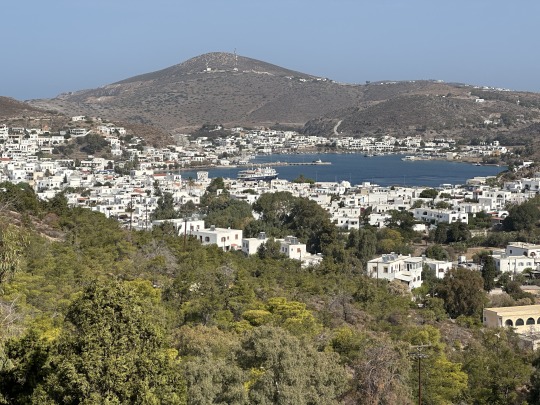
View On WordPress
#Bruce Stambaugh#Cave of the Apocalypse#Greece#island hopping#Monastery of St. John the Theologian#Patmos#Roadkill Crossing
2 notes
·
View notes
Text
📍Patmos island,Greece 🇬🇷
The “Holy” and at the same time cosmopolitan Island
Patmos may be world-famous for its religious heritage, as it was there that the Evangelist John wrote the Apocalypse, but it is also an ideal destination for nature lovers, and has evolved in recent years into a cosmopolitan destination, while maintaining its mystical atmosphere, attracting travelers seeking inner search.
Its unique geomorphological relief with its lacy coastline, steep peaks and volcanic soil combines harmoniously with the mild tourist development, making Patmos an ideal destination for lovers of rural tourism. Equally special in beauty are, however, the labyrinthine cobblestone streets, the paved squares, the traditional mansions, the crystal beaches, the good food, which make the “island of the Apocalypse” a top tourist destination.
The Greek state, in 1981, declared Patmos a “Holy Island”, while in 1999, UNESCO classified the Chora of Patmos, the Monastery of St. John the Theologian & the Cave of the Apocalypse as World Heritage Sites. At the same time, Patmos belongs to the COESIMA network, as one of the seven most important places of pilgrimage in Europe.
Text:Visit Greece google.
🎥: @giorgos_petakos
Καλημ��ρα Ελλάδα!!
#travel #travelingare #patmos #apocalypse #island #evangelist #john #holyisland #monastery #kalimera #ellada
#lifestyle#myuploads#aesthetic#travel#travelingare#drone photography#architecture#greece#kalimera ellada#patmos island#holy island#monastery of st.John
8 notes
·
View notes
Text
Daily Scripture Readings and Lives of the Saints for Wednesday, April 30, 2025
Fast Day (Wine and Oil Allowed)
Feasts and Saints celebrated today:
James the Apostle and brother of St. John the Theologian
Argyra the New Martyr
Clement the Hymnographer
Erconwald, Bishop of London
Readings for today:
Acts of the Apostles 12:1-11
Luke 9:1-6
James the Apostle and brother of St. John the Theologian
Reading from the Synaxarion:
James was one of the Twelve, like his brother John (celebrated on Sept. 26), whom the Lord called "Sons of Thunder," because they became great preachers and because of their profound theology. It was the Saint's boldness in preaching the Gospel that Herod Agrippa, the son of Aristobulus and grandson of Herod the Great, could not endure, and so he took him into custody during the days of the Passover, and slew him with the sword (Acts 12: 1-2); and thus he drank the cup of which the Saviour had spoken to him prophetically (Matt. 20:23). As for Herod, the following year he went down to Caesarea, and, as the Acts of the Apostles records: "Upon a set day, Herod, arrayed in royal apparel, sat upon his throne, and made an oration" to the elders of Tyre and Sidon; and the flatterers that surrounded him "gave a shout, saying, 'it is the voice of a god, and not of a man.' And immediately an Angel of the Lord smote him, because he gave not God the glory; and like his grandfather (see Dec. 2 9) "he was eaten of worms and gave up the spirit" (Acts 12:21-23)
Apolytikion of Apostle James in the Third Tone
O Holy Apostle James, intercede to our merciful God, that He may grant our souls forgiveness of sins.
Kontakion of Apostle James in the Second Tone
The voice of thy God thou heardest when it called to thee, O glorious James; hence, casting off thy father's love, thou together with John thy brother didst run straightway to Christ the Lord, and with him was granted to see the Lord's most divine Transfiguration.
The content on this page is under copyright and is used by permission. All rights reserved. These works may not be further reproduced, in print or on other websites or in any other form, without the prior written authorization of the copyright holder:
Reading (c) Holy Transfiguration Monastery - Brookline, MA
Apolytikion of Apostle James (c) Narthex Press
Kontakion of Apostle James (c) Holy Transfiguration Monastery, Brookline, MA
Prayer Before Reading Scripture
Shine within our hearts, loving Master, the pure light of Your divine knowledge and open the eyes of our minds that we may comprehend the message of Your Gospel. Instill in us also reverence for Your blessed commandments, so that having conquered all sinful desires, we may pursue a spiritual life, thinking and doing all those things that are pleasing to You. For You, Christ our God, are the light of our souls and bodies, and to You we give glory together with Your Father who is without beginning and Your all holy, good, and life giving Spirit, now and forever and to the ages of ages. Amen.
Epistle Reading
The Reading is from Acts of the Apostles 12:1-11
About that time, Herod the king laid violent hands upon some who belonged to the church. He killed James the brother of John with the sword; and when he saw that it pleased the Jews, he proceeded to arrest Peter also. This was during the days of Unleavened Bread. And when he had seized him, he put him in prison, and delivered him to four squads of soldiers to guard him, intending after the Passover to bring him out to the people. So Peter was kept in prison; but earnest prayer for him was made to God by the Church.
The very night when Herod was about to bring him out, Peter was sleeping between two soldiers, bound with two chains, and sentries before the door were guarding the prison; and behold, an angel of the Lord appeared, and a light shone in the cell; and he struck Peter on the side and woke him, saying, "Get up quickly." And the chains fell off his hands. And the angel said to him, "Wrap your mantle around you and follow me." And he went out and followed him; he did not know that what was done by the angel was real, but thought he was seeing a vision. When they had passed the first and the second guard, they came to the iron gate leading into the city. It opened to them of its own accord, and they went out and passed on through one street; and immediately the angel left him. And Peter came to himself, and said, "Now I am sure that the Lord has sent his angel and rescued me from the hand of Herod and from all that the Jewish people were expecting."
Gospel Reading
The Reading is from the Gospel According to Luke 9:1-6
At that time, Jesus called the twelve together and gave them power and authority over all demons and to cure diseases, and he sent them out to preach the kingdom of God and to heal. And he said to them, "Take nothing for your journey, no staff, nor bag, nor bread, nor money; and do not have two tunics. And whatever house you enter, stay there, and from there depart. And wherever they do not receive you, when you leave that town shake off the dust from your feet as a testimony against them." And they departed and went through the villages, preaching the gospel and healing everywhere.



#christian blog#christian faith#christian living#christian quotes#christianity#orthodox#eastern orthodoxy#westvirginia#maryland#potomachighlands#ancient christianity#orthodox christianity#holy orthodoxy#orthodox church#holyscriptures#bible#lectionary#western maryland#md#wva#cumberland#frostburg#keyserwv#faith in jesus
4 notes
·
View notes
Photo
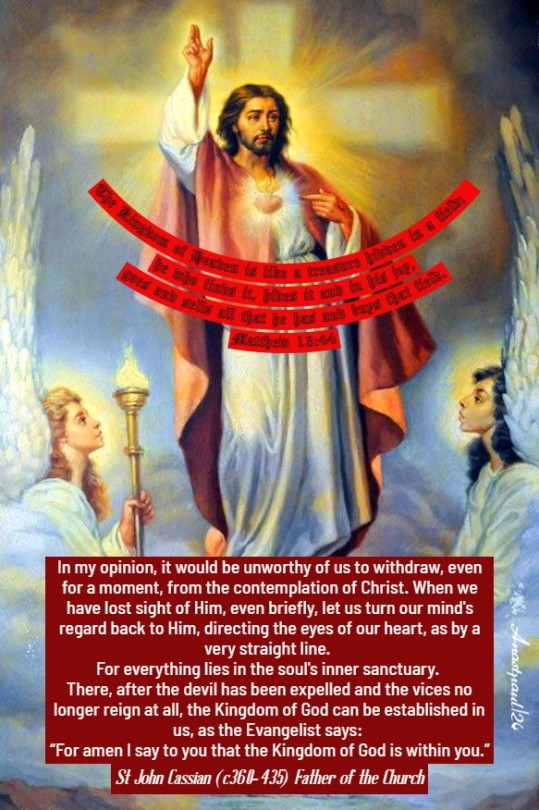
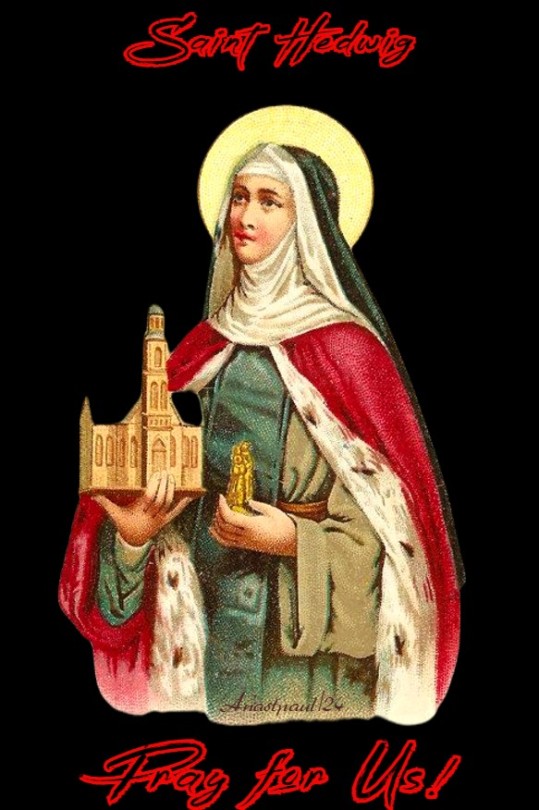
One Minute Reflection – 16 October – “The Month of the Most Holy Rosary and of the Angels” – Feast of the Purity of the Blessed Virgin Mary and of St Hedwig of Andechs (1174-1243) Widow – Proverbs 31:10-31, Matthew 13:44-52 – Scripture search here: https://www.drbo.org/ “The Kingdom of Heaven is like a treasure hidden in a field; he who finds it, hides it and in his joy, goes and sells all that he has and buys that field.” – Matthew 13:44 REFLECTION – “In my opinion, it would be unworthy of us to withdraw, even for a moment, from the contemplation of Christ. When we have lost sight of Him, even briefly, let us turn our mind’s regard back to Him, directing the eyes of our heart, as by a very straight line. For everything lies in the soul’s inner sanctuary. There, after the devil has been expelled and the vices no longer reign at all, the Kingdom of God can be established in us, as the Evangelist says: “For amen I say to you that the Kingdom of God is within you.” But within us there can be nothing else than knowledge or ignorance of the truth and the love, of either the vices, or the virtues, by which we make ready a Kingdom in our hearts, either for the devil or for Christ. The Apostle Paul also describes the characteristics of this Kingdom when he says: “For the Kingdom of God is not food and drink but righteousness and peace and joy in the Holy Ghost.” Thus, if the Kingdom of God is within us and the Kingdom of God is itself, righteousness and peace and joy, then, whoever abides in these things, is undoubtedly in the Kingdom of God … Let us lift up the eyes of our soul to that Kingdom which is endless joy!” – St John Cassian (c360-435) Monk, Theologian, Founder of Monasteries, Father of the Church, Disciple of St John Chrysostom (Conferences No 1).
(via One Minute Reflection – 21 August– ‘ … For everything lies in the soul’s inner sanctuary. …’ – AnaStpaul)
7 notes
·
View notes
Text
SAINTS&READING: THURSDAY, 30 JANVIER, 2025
janaury 17 _ january 30
St Anthony the Great

St. Anthony the Great, Troparion, Tone IV — Emulating the demeanor of the zealous Elijah, and following the Baptist with forthright steps, O father Anthony, thou wast a dweller in the desert, and hast made the whole world steadfast by thy supplications. Wherefore, entreat Christ God, that our souls be saved.
Kontakion, Tone II, "Seeking the highest" — Having cast off the tumults of life, thou didst live a life of stillness to the end, emulating the Baptist in every way, O all-venerable one. Wherefore, we honor thee with him, O Anthony, first among the father
THE HOLY EMPEROR THEODOSIUS THE GREAT (395)

The Holy Emperor Theodosius the Great during his reign (379-395) delivered a decisive blow to paganism by issuing an edict, under which any sort of service to the pagan gods was considered a violation of the law. The zealous proponent of Orthodoxy promulgated many laws in defense of the Church and against heretics. He convened the Second Ecumenical Council (381).
He ended his life in Milan in 395 at the age of fifty. Saint Theodosius often said that he was more fortunate to be a member of Christ’s holy Church than an emperor.
St. MACARIUS KALOGERAS, HIERODEACON OF PATMOS (1737) (1737).

He was born to a prosperous family on the island of Patmos. As soon as he was old enough to leave home, he attended the Patriarchal School in Constantinople, where he distinguished himself. He became a monk, then a deacon, but always refused to be ordained to the priesthood, though the Metropolitan of Nikomedia wished Makarios to be his successor. Instead, he returned to Patmos in 1713 and entered the Monastery of St John the Theologian, where he remained until his death. Though he lived in great asceticism and constant prayer, Saint Makarios was moved by a concern for the salvation and education of the Orthodox people, who often lived in great ignorance, even of their own faith, under Ottoman rule. He established a school in a building adjacent to the monastery and offered courses free of charge to any who could come. Modeling the curriculum on that of the Patriarchal School, he served more as a spiritual father than a worldly professor. The school grew steadily, partly due to generous contributions from a few wealthy Greek families and trade guilds in Constantinople. However, many of the students were very poor and still had to pay for their own needs, and Saint Makarios used his own funds to aid the poorest of them. In addition, he secretly distributed any money that came to him personally to the poor on Patmos. The school at Patmos became famous throughout the Greek Church, and its head became a spiritual father to his students and the Greek nation. Bishops often asked him to write homilies; about sixty were published in book form as The Trumpet of the Gospel, which is still widely read today by the faithful. Having greatly edified thousands while laboring tirelessly for the salvation of his soul, Saint Makarios reposed in peace in 1737.


Hebrews 13:17-21
17 Obey those who rule over you, and be submissive, for they watch out for your souls, as those who must give account. Let them do so with joy and not with grief, for that would be unprofitable for you. 18 Pray for us; we are confident that we have a good conscience in all things, desiring to live honorably. 19 But I especially urge you to do this, that I may be restored to you the sooner. 20 Now may the God of peace who brought up our Lord Jesus from the dead, that great Shepherd of the sheep, through the blood of the everlasting covenant, 21 make you complete in every good work to do His will, working in you what is well pleasing in His sight, through Jesus Christ, to whom be glory forever and ever. Amen.
Luke 6:17-23
17 And He came down with them and stood on a level place with a crowd of His disciples and a great multitude of people from all Judea and Jerusalem, and from the seacoast of Tyre and Sidon, who came to hear Him and be healed of their diseases, 18 as well as those who were tormented with unclean spirits. And they were healed. 19 And the whole multitude sought to touch Him, for power went out from Him and healed them all. 20 Then He lifted up His eyes toward His disciples and said: Blessed are you poor, For yours is the kingdom of God. 21 Blessed are you who hunger now, For you shall be filled. Blessed are you who weep now, For you shall laugh. 22 Blessed are you when men hate you, And when they exclude you, And revile you, and cast out your name as evil, For the Son of Man's sake. 23 Rejoice in that day and leap for joy! For indeed your reward is great in heaven, For in like manner their fathers did to the prophets.
#orthodoxy#orthodoxchristianity#easternorthodoxchurch#originofchristianity#spirituality#holyscriptures#gospel#bible#wisdom#faith#saints#prophets
3 notes
·
View notes
Text


Georgia (2) by Vat Vjacheslav
Via Flickr:
(1) Bridge on Adjara rivers. (2) Courtyard of the Monastery of St. John the Theologian, built on the ruins of a temple of the VII-VIII centuries.
4 notes
·
View notes
Text




A new Orthodox church was formally opened in Jordan on Sunday, February 18, by His Beatitude Patriarch Theophilos of Jerusalem.
The Patriarch was joined by His Highness Prince Ghazi bin Muhammad, Chief Advisor to His Majesty the King of Jordan for Religious and Cultural Affairs, for the opening of the Three Holy Hierarchs Orthodox Church, within the Orthodox Center project next to the Holy Theotokos, Life-Giving Spring Monastery in Dibeen, Jerash Governorate, reports the Jerusalem Patriarchate.
His Eminence Archbishop Christophoros of Kyriakopolis also attended the opening. He emphasized that “the church will meet the needs of young people, and will be a place for holding conferences, meeting intellectually and culturally, and serving the local community.”
He also thanked Mr. Issa Nassif Odeh, who made a generous donation to complete the construction of the church.
The new church is the first in Jordan to be named for the Three Holy Hierarchs—Sts. Basil the Great, Gregory the Theologian, and John Chrysostom.
The church combines traditional Jordanian geometric designs “with a Byzantine architectural spirit.”
The first Divine Liturgy will be celebrated on Friday, February 23.
The Patriarchate of Jerusalem site currently lists 40 other monasteries and churches in Jordan.
An historic Divine Liturgy was celebrated in a Byzantine-era church in Petra, Jordan, for the first time in 1,500 years last month.
[Source: OrthoChristian.com]
8 notes
·
View notes
Text
THIS DAY IN GAY HISTORY
based on: The White Crane Institute's 'Gay Wisdom', Gay Birthdays, Gay For Today, Famous GLBT, glbt-Gay Encylopedia, Today in Gay History, Wikipedia, and more … October 28



1466 – Erasmus was a Dutch humanist and theologian, who merits serious consideration by queer people of faith. Born Gerrit Gerritszoon, he became far better known as Desiderius Erasmus of Rotterdam: Erasmus was his saint's name, after St. Erasmus of Formiae; Rotterdam, for the place of his birth (although he never lived there after the first few years of early childhood; and "Desiderius" a name he gave himself - "the one who is desired".
He left a legacy as a scholar and church reformer. His career spanned the years leading up to, and after, Martin Luther's break with the Catholic Church that became the Protestant Reformation. Prior to the split, Erasmus had himself been fiercely critical of the Church, arguing forcefully for reform of the many and manifold abuses. He had close relationships with Luther and many other leading members of the Reformation movement, which his ideas strongly influenced. However, when the break came, he chose to remain formally inside the church structures, and not outside of it.
Some LGBT activists have hailed Erasmus as a gay icon from history. Circa Club for instance has no doubt, using that precise term and including Erasmus in it's collection of historical gay icons. The primary basis of the claim is a series of passionate love letters he wrote to a young monk Servatius Rogerus. While at the Augustinian monastery at Stein near Gouda around 1487, Erasmus wrote passionate letters of friendship to the fellow monk, whom he called "half my soul", writing, "I have wooed you both unhappily and relentlessly"; this correspondence contrasts sharply with the generally detached and much more restrained attitude he showed in his later life.There were also allegations of improper advances made to the young Thomas Grey, later Marquis of Dorset, while employed as his tutor.
Erasmus's best-known work was The Praise of Folly, a satirical attack on the traditions of the Catholic Church and popular superstitions, written in 1509, published in 1511 and dedicated to his friend, Sir Thomas More.


1754 – John Laurens (d.1782) was an American soldier and statesman from South Carolina during the Revolutionary War. He gained approval by the Continental Congress in 1779 to recruit a regiment of 3000 slaves by promising them freedom in return for fighting. He died in 1782, but his father manumitted their slaves as he had intended.
Laurens was born in Charleston, South Carolina. After tutoring at home and the death of his mother, John and his two younger brothers were taken by their father to England. John completed his education in Europe, first in London, then in Geneva. As a youth, he yielded to his father's wish that he study law in London. In late 1776, John was obliged, "out of pity," to marry Martha Manning, the daughter of one of his father's London agents, and in December he sailed for Charleston. He left his wife behind, pregnant with a daughter who he would never see.
In the summer of 1777, he accompanied his father, Henry Laurens, on the trip to Philadelphia where Henry was to serve in the Continental Congress and where in spite of his father's strong objections, John continued on to Washington's camp as a volunteer.
Laurens joined the main army of the Continental Army and within a month, following the Battle of Brandywine, was made officially an aide-de-camp to General Washington with the rank of Lieutenant Colonel. He became very good friends with his fellow aides, Alexander Hamilton, and with the Marquis de Lafayette. He also gave the first demonstrations of his tendency to reckless courage at the Battles of Brandywine, Germantown in which he was wounded, and Monmouth where his horse was shot out from under him.
As the British stepped up operations in the South, Laurens, who had long argued that "We Americans at least in the Southern Colonies, cannot contend with a good Grace, for Liberty, until we shall have enfranchised our Slaves," promoted the idea of arming slaves and granting them freedom in return for their service, and in early 1778 requested, as a start, 40 slaves from his father, which Henry, now President of the Continental Congress, granted but with such serious reservations about the practicality that John temporarily relinquished the project. In March 1779 Congress approved this idea, commissioned him Lieutenant Colonel, and sent him south to implement a regiment of 3000. He won election to the South Carolina House of Representatives, and introduced his black regiment plan in 1779 and 1780 (and again in 1782) only to meet overwhelming rejection each time. His belief that blacks shared a similar nature with whites and could aspire to freedom in a republican society set Laurens apart from other leaders in revolutionary South Carolina.
There is evidence of Laurens enjoying a sexual and loving relationship with Alexander Hamilton. These reports are based upon letters Hamilton wrote Laurens during a period in which Laurens was absent from the camp. In preparing a biography, Hamilton's family actually crossed out parts of letters they each sent one another. Suspiciously enough many of Laurens letters to Hamilton are missing. But the language in Hamilton's letters reveal a profound love for Laurens. Indeed Hamilton was never as emotionally open with any other man in his lifetime, and the depths of sentiment are equaled only in letters he wrote to his wife Eliza. Hamilton wrote:
"Cold in my professions, warm in my friendships, I wish, my Dear Laurens, it might be in my power, by action rather than words, to convince you that I love you."
In September 1779, gently chiding Laurens for not corresponding as often as he would have liked, Hamilton wrote, "like a jealous lover, when I thought you slighted my caresses, my affection was alarmed and my vanity piqued."
Looking beyond the successful conclusion of the war, Hamilton suggested that both of them should be members of the congress of the new country. "We have fought side by side to make America free, let us hand in hand struggle to make her happy," he wrote in a letter ending, "Yours forever."
Laurens probably never read this letter as he was killed in a skirmish a few days after it was written.


1824 - French historian Astolphe de Custine is beaten by soldiers he solicited. He reluctantly files charges against them.

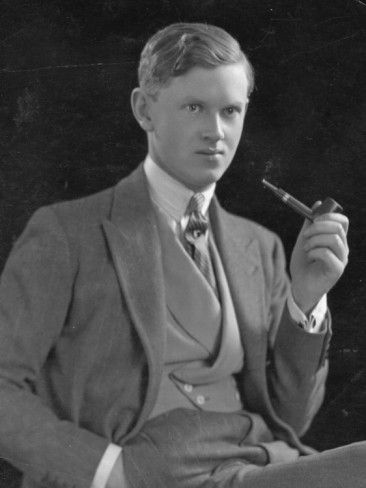
1903 – British poet and novelist Evelyn Waugh was born on this date (d.1996). The English writer is best known for such satirical and darkly humorous novels as Decline and Fall, Vile Bodies, Scoop, A Handful of Dust and The Loved One, as well as for broader and more personal works, such as Brideshead Revisited and the Sword of Honor trilogy, that are influenced by his own experiences and his conservative and Catholic viewpoints. Many of Waugh's novels depict British aristocracy and high society, which he satirizes but to which, paradoxically, he was also strongly attracted. In addition, he wrote short stories, three biographies, and the first volume of an unfinished autobiography. His travel writings and his extensive diaries and correspondence have also been published.
The overt homosexuality of his brother Alec Waugh may have caused Evelyn to hide his own tendencies behind two marriages and seven children. Alec Waugh, like their father, publisher Arthur Waugh, had gone to school at Sherborne, and it was assumed that Evelyn would follow. However, in 1915 Alec was asked to leave, after a homosexual relationship came to light. He departed for military training, and while waiting for his commission to be confirmed wrote a novel of school life, The Loom of Youth, which was published by Chapman and Hall. The novel, which alluded to homosexual friendships in what was recognisably Sherborne, caused a public sensation and offended the school sufficiently to make it impossible for Evelyn to go there. Much to his annoyance he was sent in May 1917 to Lancing, in his view a decidedly inferior establishment. He later went to Oxford.
He arrived in Oxford in January 1922; in October 1922 the arrival of the sophisticated Etonians Harold Acton and Brian Howard changed Waugh's Oxford life. Acton and Howard rapidly became the centre of an avant-garde circle known as the Hypocrites, whose artistic, social and homosexual values Waugh adopted enthusiastically; he later wrote: "It was the stamping ground of half my Oxford life". He began drinking heavily, and embarked on the first of several homosexual relationships, the most lasting of which were with Richard Pares and Alastair Graham.
After gallantly protecting T. S. Eliot from "the specious assumption that he was homosexual," T.S. Matthews in Great Tom, suddenly became viciously ungallant: "It is peppery, glaring little men like Evelyn Waugh who are sexually suspect - as his diaries bear witness."
Indeed, his diaries do clearly reveal him as a Gay man. But then so do his novels, particularly Brideshead Revisited, in which the friendship of Charles and Sebastian, despite the limitations of what he was allowed to write in the early 1940s, is magnificently drawn.


Francis Bacon Self-portrait 1972
1909 – The Anglo-Irish born painter Francis Bacon (d.1992) was a descendant of the Elizabethan philosopher Francis Bacon. His artwork is well known for its bold, austere, and often grotesque or nightmarish imagery. Bacon's painterly but abstract figures typically appear isolated in glass or steel geometrical cages set against flat, nondescript backgrounds. He began painting during his early 20s and worked only sporadically until his mid 30s. Before this time he drifted, earning his living as an interior decorator and designer of furniture and rugs
Bacon early discovered that he attracted a certain type of rich man, an attraction he was quick to take advantage of, having developed a taste for good food and wine. One of the men was an ex-army friend of his father, another breeder of race-horses, named Harcourt-Smith. Bacon later claimed that his father had asked this friend to take him 'in-hand' and 'make a man of him'. Francis had a difficult relationship with his father, once admitting to being sexually attracted to him. Doubtless, Eddy Bacon was aware of his friend's reputation for virility, but not of his penchant for young men. In the early Spring of 1927 Bacon was taken by Harcourt-Smith to the opulent, decadent, "wide open" Berlin of the Weimar Republic, staying together at the Hotel Adlon.
His visit to a 1927 exhibition of 106 drawings by Picasso at the Galerie Paul Rosenberg, Paris, aroused his artistic interest, and he often took the train to Paris five or more times a week to see shows and art exhibitions.
In 1929 he met Eric Hall at the Bath Club, Dover Street, London, where Bacon was working at the telephone exchange. Hall (who was general manager of Peter Jones) was to be both patron and lover to Bacon, in an often torturous relationship.
In 1964, Bacon began a relationship with 39-year-old Eastender George Dyer, whom he met, he claimed, while the latter was burgling his apartment. A petty criminal with a history of juvenile detention and prison, Dyer was a somewhat tortured individual, insecure, alcoholic, appearance obsessed and never really fitting in within the bohemian set surrounding Francis. The relationship was stormy and in 1971, on the eve of Bacon's major retrospective at the Paris Grand Palais, Dyer committed suicide in the hotel room they were sharing, overdosing on barbiturates. The event was recorded in Bacon's 1973 masterpiece Triptych, May-June 1973.
In 1974, Bacon met John Edwards, a young, illiterate, handsome Eastender with whom he formed one of his most enduring friendships, eventually bequeathing his £11m fortune to Edwards after his death.
Bacon died of a sudden heart attack on April 28, 1992, in Madrid, Spain. Bacon bequeathed his entire estate (then valued at eleven million pounds) to John Edwards after his death. Edwards, in turn, donated the contents of Francis Bacon's chaotic studio in South Kensington, to the Hugh Lane gallery in Dublin. Bacon's studio contents were moved and the studio carefully reconstructed in the gallery. Additionally draft materials, perhaps intended for destruction, were according to Canadian Barry Joule bequeathed to Joule who later forwarded most of the materials to create the Barry Joule Archive in Dublin with other parts of the collection given later to the Tate museum.
Bacon's Soho life was portrayed by John Maybury, with Derek Jacobi as Bacon and Daniel Craig as George Dyer (with some lovely frontal nudity on Craig's part) and with Tilda Swinton as Muriel Belcher, in the film Love is the Devil (1998), based on Daniel Farson's 1993 biography The Gilded Gutter Life of Francis Bacon.


1949 – Caitlyn Jenner (born William Bruce Jenner), known as Bruce Jenner until 2015, is an American television personality and former track and field athlete.
A former college football player, Jenner came to international attention as a decathlete, winning the gold medal in the men's decathlon event at the 1976 Summer Olympics in Montreal, and setting a world record not beaten until 1980. With the unofficial title of "world's greatest athlete" for the Olympic decathlon win, he was also an American cult hero winning an event dominated by Soviet Union athletes during the Cold War. He leveraged his celebrity status to endorse products and subsequently starred in numerous movies and television specials including several made-for-TV movies, and was briefly Erik Estrada's replacement on the TV series CHiPs.
Jenner was married for 23 years to Kris Jenner (née Houghton; formerly Kardashian); the couple and their children appeared beginning in 2007 on the television reality series Keeping Up with the Kardashians. Following their divorce in 2015, Jenner came out in a television interview as a trans woman, initially preferring masculine pronouns until his transition was more complete. In June 2015, Jenner revealed her new name, Caitlyn, and a preference for being referred to using feminine pronouns. Many news sources have described her as the most famous openly transgender person in the world.

Bruce Jenner that was.
Jenner is a professed Christian, leans politically conservative, and is a Republican. Prior to her public gender transition, she had been married three times. Her first marriage was to Chrystie Scott (née Crownover) from 1972 to 1981. They have two children, son Burton and daughter Cassandra, known as Burt and Casey. Jenner and Scott's divorce was finalized the first week of January 1981. The same week, on January 5, 1981, Jenner married actress Linda Thompson, in Hawaii. By February 1986, Jenner and Thompson had separated, and they subsequently divorced. They have two sons together, Brandon and Sam Brody, known as Brody. The two sons starred on the reality show The Princes of Malibu and Brody Jenner was also on the reality show The Hills.
Jenner's third marriage, to Kris Kardashian (née Houghton), occurred on April 21, 1991, after five months of dating. They have two daughters, Kendall and Kylie. While married, Jenner was also the step-parent to Kris's four children from her previous marriage to the late lawyer Robert Kardashian: Kourtney, Kim, Khloé and Rob. The couple announced their separation in October 2013, though they had actually separated a year earlier. Kris filed for divorce in September 2014, citing irreconcilable differences. Their divorce terms were finalized in December 2014 and went into effect on March 23, 2015, because of a six-month state legal requirement.
In an April 2015, 20/20 interview with Diane Sawyer, Jenner came out as a trans woman saying she had dealt with gender dysphoria since her youth, and that, for all intents and purposes, "I’m a woman." Jenner cross dressed for many years and did hormone replacement therapy but stopped after the romance with Kris Kardashian in the early 1990s became more serious. Caitlyn recounts having permission to explore her gender identity on her own travels but not when they were coupled, and that not knowing the best way to talk about the many issues contributed to the deterioration of the 22-year-long marriage which formally ended in 2013.


1987 – Frank Ocean (born Christopher Breaux) is an American singer-songwriter and rapper. Ocean started his career as a ghostwriter for artists such as Brandy, Justin Bieber, and John Legend. In 2010, he became a member of alternative hip hop collective OFWGKTA also known as Odd Future, and his debut mixtape, Nostalgia, Ultra, was released to critical acclaim in 2011. The singles "Novacane" and "Swim Good" both achieved chart success.
His debut studio album, Channel Orange, was released in July 2012, promoted with three charting singles: "Thinkin Bout You", "Pyramids", and "Sweet Life".
In 2005, Hurricane Katrina hit Ocean's hometown of New Orleans and his recording facility was destroyed by floodwater and looting. To continue recording music, he moved to Los Angeles and intended to stay for just six weeks but decided to stay longer and develop his music career after establishing contact with people in the music industry. He recorded some demos at a friend's studio and shopped them around Los Angeles.
After getting a songwriting deal, he started working with other record producers and wrote songs for artists such as Justin Bieber, John Legend, Brandy, and Beyoncé. Ocean later said of his work at the time, "There was a point where I was composing for other people, and it might have been comfy to continue to do that and enjoy that income stream and the anonymity. But that's not why I moved away from school and away from family."
Ocean became one of the first major African-American music artists to announce that he had once fallen in love with someone of the same sex, notable because that music scene is known for homophobia.Ocean wrote an open letter, initially intended for the liner notes on Channel Orange, that would preemptively address speculation about his same-sex attraction. Instead, on July 4, 2012, he published an open letter on his Tumblr blog recounting unrequited feelings he had for another young man when he was 19 years old, citing it as his first true love. He used the blog to thank the man for his influence, and also thanked his mother and other friends, saying "I don't know what happens now, and that's alrite. I don't have any secrets I need kept anymore … I feel like a free man."
Members of the hip hop industry generally responded positively to the announcement. Russell Simmons, a business magnate in the hip hop industry, wrote a congratulatory article in Global Grind saying "Your decision to go public about your sexual orientation gives hope and light to so many young people still living in fear." Other artists who expressed their support included Beyoncé and Jay-Z.


1990 – Placido Domingo and Andre Watts raised $1.5 million at a fundraiser for the Gay Men's Health Crisis.


1998 – On this date Welsh secretary Ron Davies resigned from Tony Blair's Labour Party government after British tabloids reported he was robbed at knife-point in a London park while looking for a male sexual companion. Although he subsequently came out as Bisexual, Davies referred to the incident as his "moment of madness."
In 1999 Davies was successfully elected on 6 May 1999 as Member of the Welsh Assembly in the Caerphilly Constituency, and chaired the Economic Development Committee after Alun Michael refused to appoint him to his Cabinet. Shortly before the 2003 assembly elections, "The Sun" revealed that Davies had been visiting a well-known cruising spot near a motorway lay-by (rest stop). When challenged as to what he had been doing there, Davies initially denied being there, then told reporters that he had been going for a short walk, adding: "I have actually been there when I have been watching badgers." Davies was forced to stand down as Labour candidate in the election.


2009 – President Barack Obama signed the The Matthew Shepard Act (officially the "Matthew Shepard and James Byrd, Jr. Hate Crimes Prevention Act") into law. The Act expanded the 1969 United States federal hate-crime law to include crimes motivated by a victim's actual or perceived gender, sexual orientation, gender identity, or disability. It was finally passed after almost two decades of attempts to pass it through Congress and over stiff opposition by members of the Republican party. During debate in the House of Representatives, Republican Representative Virginia Foxx of North Carolina called the "hate crime" labeling of Shepard's murder a "hoax."


5 notes
·
View notes
Text
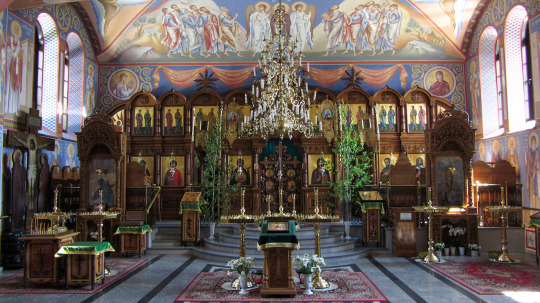
PL:
Cerkiew św. Jana Teologa, Monaster Zwiastowania Przenajświętszej Bogurodzicy, Supraśl
Wzniesiona z czerwonych cegieł między rokiem 1889 a 1890 w obrębie monasterskich budynków. Służy wiernym (i mnichom) jako ciepła, zimowa cerkiew. Przybudowana została do istniejącego południowego korpusu monastycznego, łącząc się bezpośrednio z nim, od strony jego elewacji wschodniej.
Jest to świątynia orientowana, na planie prostokąta ze strukturą trójdzielną typową dla świątyni prawosławnej.
Pierwotny ikonostas nie zachował się. Obecny ikonostas powstał współcześnie. Ikony do tego ikonostasu zostały napisane w Studium Ikonograficznym w Bielsku Podlaskim, pod kierunkiem ks. Leoncjusza Tofiluka.
EN:
Church of St. John the Theologian, Monastery of the Annunciation of the Most Holy Theotokos, Supraśl, Poland
Built of red bricks between 1889 and 1890 within the monastery buildings. It serves the faithful (and monks) as a warm winter church. It was added to the existing southern monastic wing, connecting directly to it from the eastern elevation.
This is an oriented temple, rectangular in shape with a three-part structure typical of Orthodox churches.
The original iconostasis has not survived. The current iconostasis was created in contemporary times. The icons for this iconostasis were painted at the Iconographic Studio in Bielsk Podlaski, under the direction of Father Leoncjusz Tofiluk.
#supraśl#cerkiew#cerkiewprawosławna#orthodox#orthodoxchurch#podlasie#kościół#church#polska#poland#świątynia#temple#chrześcijaństwo#christianity#wiara#religia#religion#ikony#ikonostas#monastery#iconostasis
4 notes
·
View notes
Text
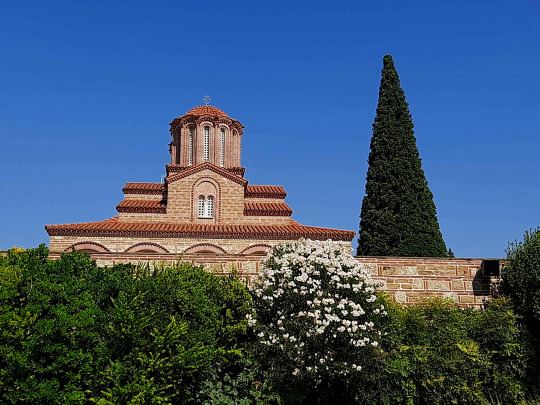
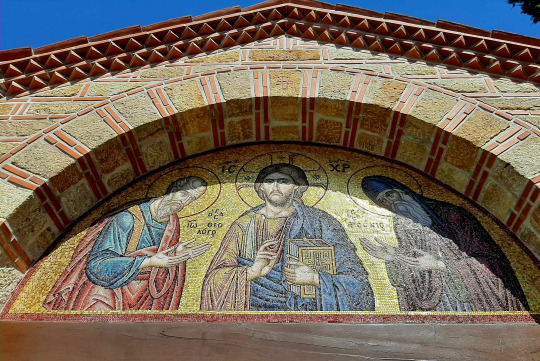

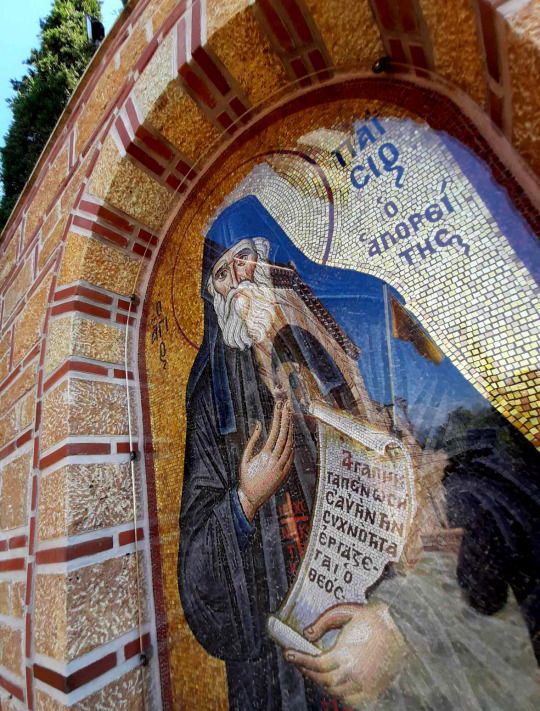
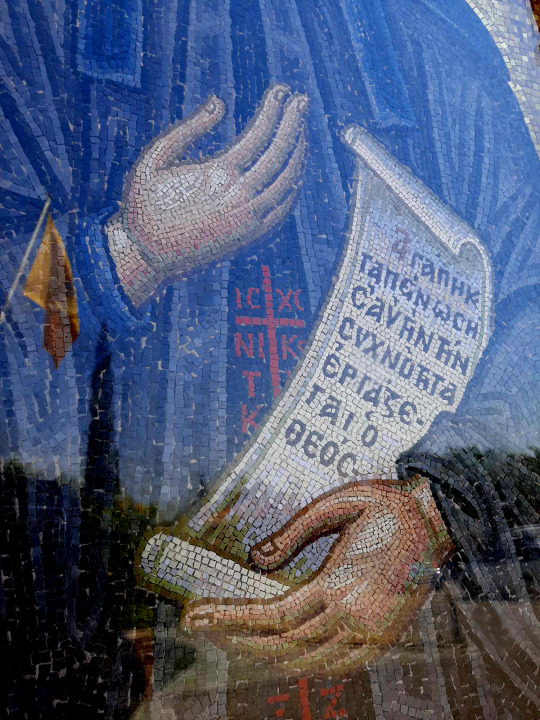

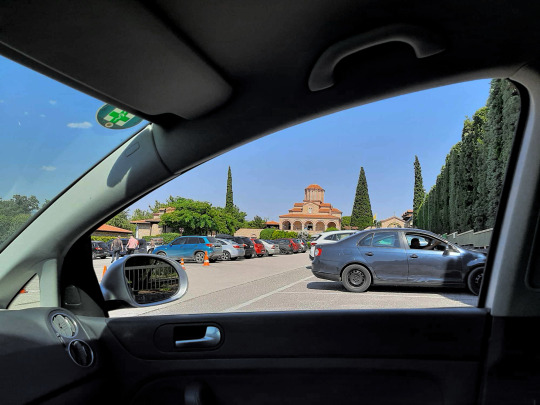

"Holy Monastery of Saint John the Theologian", Souroti, Thessaloniki, Greece _ Photos by: Spyros Kaprinis [12.07.2024].
"The Monastery of St. John the Theologian is a Greek Orthodox Christian nunnery located in Souroti, Greece. It was founded in 1967. The tomb of Saint Paisios of Mount Athos is located in the monastery. The relics of Saint Arsenios the Cappadocian are also kept in the monastery."
#Monastery#Saint John the Theologian#Souroti#Thessaloniki#Greece#Saint Paisios#Άγιος Παΐσιος#Saint Arsenios#Άγιος Παΐσιος ο Αγιορείτης#Πρόδρομος Ἐζνεπίδης#Ἅγιος Ἀρσένιος#Σπύρος Καπρίνης#Spyros Kaprinis#Ιούλιος#July#2024
2 notes
·
View notes
Text

THE DESCRIPTION OF SAINT JOHN OF DAMASCUS (John Damascene) Feast Day: December 4
"I do not worship matter, I worship the God of matter, who became matter for my sake and deigned to inhabit matter, who worked out my salvation through matter. I will not cease from honoring that matter which works for my salvation. I venerate it, though not as God."
John was born into a wealthy family at Damascus and spent his entire life under Islamic rule. The ancestors of John, according to his biographer, had alone remained faithful to Christianity when Damascus fell into the hands of the Arabs. They commanded the respect of the conqueror, and were employed in judicial offices of trust and dignity, to administer, no doubt, the Christian law to the Christian subjects of the Sultan. His father, besides this honorable rank, had amassed great wealth; all this he devoted to the redemption of Christian slaves to whom he gave freedom. John was the reward of these pious actions.
John was baptized immediately on his birth, probably by Peter II, bishop of Damascus (and afterwards a sufferer for the Faith). The father was anxious to keep his son aloof from the savage habits of war and piracy to which the youths of Damascus were addicted, and to devote him to the pursuit of knowledge. The Saracen pirates of the seashore neighboring to Damascus swept the Mediterranean and brought in Christian captives from all quarters. A monk named Cosmas had the misfortune to fall into the hands of these freebooters. He was set apart for death when his executioners, Christian slaves no doubt, fell at his feet and entreated his intercession with the Redeemer.
The Saracens inquired of Cosmas who he was. He replied that he had not the dignity of a priest; he was a simple monk, and burst into tears. The father of John was standing by, and expressed his surprise at this exhibition of timidity. Cosmas answered, "It is not for the loss of my life, but of my learning, that I weep."
Then, he recounted his attainments, and the father of John, thinking he would make a valuable tutor for his son, begged (or bought) his life, gave him his freedom, and placed his son under his tuition. The pupil in time exhausted all the acquirements of his teacher. The monk then obtained his dismissal and retired to the monastery of St. Sabas, where he would have closed his days in peace, had he not been compelled to take on himself the bishopric of Majuma, at the port of Gaza.
The attainments of the young John of Damascus commanded the veneration of the Saracens; he was compelled reluctantly to accept an office of higher trust and dignity than that held by his father. As the Iconoclastic controversy became more violent, John of Damascus entered the field against the Emperor of the East, and wrote the first of his three treatises on the Veneration Due to Images. This was probably composed immediately after the decree of Leo the Isaurian against images in 730. Before he wrote the second, he was apparently ordained priest, for he speaks as one having authority and commission. The third treatise is a recapitulation of the arguments used in the other two. These three treatises were disseminated with the utmost activity throughout Christianity.
His writings, especially his De Fide Orthodoxa, one of the most notable theological works of antiquity, has had great influence on the theologians of both East and West. He also wrote poetry and some of his poems are used in the Greek liturgy. John died at Sabas, in December, and was made a Doctor of the Church by Pope Leo IIII in 1890.
Source: Catholic Exchange
2 notes
·
View notes
Text
Today the Church remembers St. Prosper of Aquitaine, Theologian.
Ora pro nobis.
Saint Prosper, "The Eradicator of Heresies," as Saint Photios calls him, was born in the Aquitaine region of Gaul around the year 390 AD. He was a renowned lay theologian, although few details of his life are known. We do know that he was married.
We know Saint Prosper chiefly from his writings. A contemporary writer described him as "a holy and venerable man." This wise man seems to have spent his life embroiled in controversies with heretics. For the semi-Pelagians in particular, Saint Prosper was one of their most fearsome adversaries. His chief fame rests not on his historical works, but on his activities and writings as a theologian and an aggressive propagator of the Augustinian doctrine of grace. It is no doubt that Prosper holds a place in the ranks of the moulders of theological understanding of the doctrine of grace.
By 417 AD, he arrived in Marseilles as a refugee from Aquitaine in the aftermath of the Gothic invasions of Gaul. Prosper played a vital role in the Pelagian controversy in southern Gaul in the 420's. With the help of Augustine and Pope Celestine, Prosper was able to put down revolutions of the Pelagian Christians.
In 429 AD, he was corresponding with Augustine. In 431 he appeared in Rome to appeal to Pope Celestine I regarding the teachings of Augustine; there is no further trace of him until 440, the first year of the pontificate of Pope Leo I, who had been in Gaul, where he may have met Prosper.
His chief work was his De gratia Dei et libero arbitrio, “On the grace of God and free will”(432), written against John Cassian's Collatio. He also induced Pope Celestine to publish an open letter to the bishops of Gaul, Epistola ad episcopos Gallorum against some members of the Gaulish Church. He had earlier opened a correspondence with Augustine, along with his friend Hilary (not Hilary of Arles), and although he did not meet him personally, his enthusiasm for the great theologian led him to make an abridgment of his commentary on the Psalms, as well as a collection of sentences from his works—probably the first dogmatic compilation of that class in which Peter Lombard's Liber sententiarum is the best-known example. He also put into elegiac metre, in 106 epigrams, some of Augustine's theological dicta.
In Saint Prosper, science was joined to virtue. It is evident that he applied himself to literature, and especially to acquiring knowledge of Holy Scripture. He was no less an expert in human sciences than he was in theology. He excelled particularly in mathematics, astronomy, and chronology. His great learning and holiness made him well known throughout the entire Church.
In a poem to his wife, he wrote: "Lift me up again if I fall; correct yourself if I point out some fault. Let it never be sufficient for us to be one body, let us also be one soul." By 428, Saint Prosper persuaded his wife to become a nun, and he entered a monastery at Marseilles.
When Saint Leo the Great was chosen as the Bishop of Rome in 440 AD, he sent for Prosper to become his secretary. Many historians believe that the admirable treatise "On the Incarnation of the Word," which is ascribed to Saint Leo, is actually the work of Saint Prosper. It is possible, however, that Saint Leo may have reworked it in his own style. Prosper gives detailed coverage of political events. He covers Attila's invasions of Gaul (451) and Italy (452) in lengthy entries under their respective years.
His writings and those of St. Augustine were pivotal during the Council of Orange in 529 AD in defining the doctrine of grace and the final repudiation of Pelagianism and semi-Pelagianism.
Saint Prosper died in Rome, c. 464 AD.
O God, by your Holy Spirit you give to some the word of wisdom, to others the word of knowledge, and to others the word of faith: We praise your Name for the gifts of grace manifested in your servant Prosper, and we pray that your Church may never be destitute of such gifts; through Jesus Christ our Lord, who with you and the Holy Spirit lives and reigns, one God, forever and ever.
Amen.
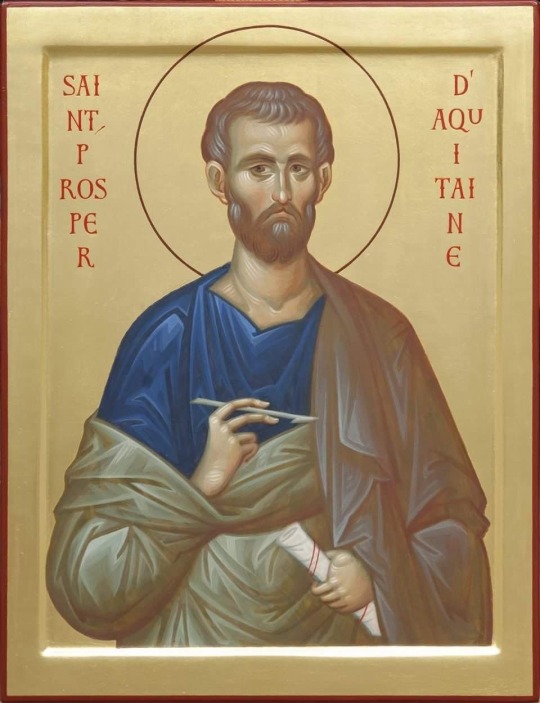
#father troy beecham#christianity#jesus#saints#god#salvation#peace#faith#early church#grace#theology
3 notes
·
View notes
Text
SAINT OF THE DAY (August 13)
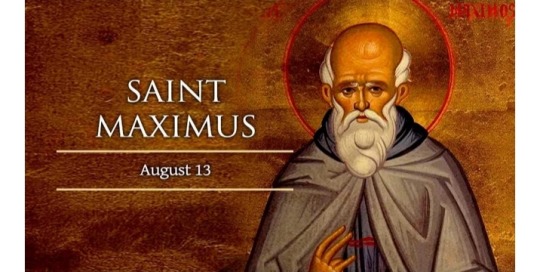
"To harbor no envy, no anger, no resentment against an offender is still not to have charity for him.
It is possible, without any charity, to avoid rendering evil for evil. But to render, spontaneously, good for evil - such belongs to a perfect spiritual love."
— Saint Maximus
St. Maximus is also known as "The Theologian" and "Maximus Confessor."
He was born in Constantinople around the year 580 and died in exile on 13 August 662.
He worked with Pope Martin I against the Monothelist heresy and attended the Lateran Council of 649.
He was one of the chief doctors of the theology of the Incarnation and ascetic mysticism.
He was remarkable as a witness to the respect for the papacy held by the Greek Church in his day.
This great man came from a noble family of Constantinople.
He became first secretary to Emperor Heraclius, who greatly valued him, but despite the favor of the emperor, Maximus resigned to the world and gave himself up to contemplation in a monastery at Chrysopolis, opposite Constantinople.
He became abbot there but seems to have left this retreat on account of its insecurity from hostile attacks.
Falsely accused of treason due to his defense of the orthodox faith, he was arrested and forcibly returned to Constantinople, where he spent several miserable years in prison.
At age 82, he received his final sentence. He was anathematized together with St. Martin and St. Sophronius.
The prefect was ordered to beat them, to cut out their tongues and lop off their right hands, to exhibit them thus mutilated in every quarter of the city, and to send them to perpetual exile and imprisonment.
A long letter of the Roman Anastasius tells us of their sufferings on the journey to Colchis where they were imprisoned in different forts.
He tells us that St. Maximus foresaw in a vision the day of his death and that miraculous lights appeared nightly at his tomb.
The monk Anastasius had died in the preceding month.
St. Maximus died for orthodoxy and obedience to Rome.
He has always been considered one of the chief theological writers of the Greek Church and has obtained the honorable title of the Theologian.
He may be said to complete and close the series of patristic writings on the Incarnation, as they are summed up by St. John of Damascus.
0 notes
Text
Synaxis of Light
Among the many theologians of the Orthodox Church, three saints are given the appellation Theologian: St. John the Theologian, St. Gregory the Theologian, and St. Symeon the New Theologian. There is a monastery in Panorama, at Thessaloniki suburbs, the Monastery of the Holy Trinity, which is the only one all over the world with a chapel dedicated to these three theologians, celebrating their…

View On WordPress
0 notes
Text
On The Island of the Apocalypse

In the book of Revelation, at the end of the New Testament, we read these words:
9 I, John, your brother and companion in the suffering and kingdom and patient endurance that are ours in Jesus, was on the island of Patmos because of the word of God and the testimony of Jesus. 10 On the Lord’s Day I was in the Spirit, and I heard behind me a loud voice like a trumpet, 11 which said: “Write on a scroll what you see and send it to the seven churches: to Ephesus, Smyrna, Pergamum, Thyatira, Sardis, Philadelphia and Laodicea.”
After this beginning, John the Revelator revealed an incredible vision that has confounded scholars and theologians for centuries.
The book of Revelation has been the source of countless misinterpretations, bad theology, fevered visions of the future, not to mention the foundation of many of the strange ideas and beliefs that many Christians hold about the end of the world.
John the Revelator's vision happened on the Greek island of Patmos, which is home to the Monastery of St. John the Theologian, founded upon the site where John is believed to have received his vision in a cave.
I had the chance to revisit the island during my trip to Greece and return to the Monastery. My visit got me thinking about many things, including all of the studies I've made of John's Revelation.
To begin with, it's important to know that the very name of the book of Revelation tells us a bit about what it's all about. The Greek name for the book is the Apocalypse of John, which reveals the kind of writing we're reading off the bat.
This kind of writing was not meant to be a future prophecy. It was a revelation of what was happening and what outcomes current events might have in the future. And the fantastical word pictures that we find in Revelation would have been completely understood by the readers.
It's also up for debate whether The Apostle John wrote the Apocalypse of John. It's been dated as having been written well after 70 AD and the destruction of Jerusalem and the Temple, and could have been written by an elder (or presbyter) who was the overseer of the seven churches mentioned in the text.
At any rate, there is a vision that occurs in the book's opening lines--a vision that happens on the island of Patmos, where hundreds of thousands of pilgrims visit each year.
During this last visit to the island, our group joined a huge queue area to visit the grotto or cave where John the Revelator had his vision and where, according to tradition, dictated what he saw to an assistant.
The wait time was over forty-five minutes to enter the Chora or Cave of the Apocalypse, which was converted into a chapel as part of the Monastery of St. John the Theologian in 1088.
As I wanted in line with the rest of my group, I reflected on how many people over the centuries have waited to enter the Chora--the curious, the devout, skeptics, tourists from cruise ships, faithful pilgrims, worshippers, and the like.
And everyone who visits has their own sense of what occurred in that cave and why it's considered a holy site.
Some believe that some sort of code needs to be cracked in the Revelation to determine the course of history. Others write it off as a legend or the ravings of an unhinged person suffering hallucinations.
There are also some (myself included) who don't take the text to be literally true and find in it a warning to followers of Jesus not to assimilate to the excesses of the Empire, whatever form the Empire takes throughout the ages.
Yet, we all gather on a remote island off the coast of Greece to stand in line for a glimpse at where this book of Revelation was conceived.
There is something quite beautiful about it, really. I had to wonder what made a place holy. Was it what happened there, or was it something else? What was it about that cave that made us all enter into it hushed into reverent silence after waiting so long for a glimpse of it?
Could it be that the place is made holy because so many of us gather there, wondering, praying, seeking understanding, longing for answers, or simply wanting to find some connection to the Divine, some glimpse of what comes next for all of us?
Perhaps this is the secret to Revelation, after all.
Like so many aspects of the Christian faith and tradition, it is a mystery. It spoke to a particular time but also speaks to all times. It was for a specific group of first-century Christians, but it was also for all followers of Jesus in all places and times.
And we find ourselves saying like those Christians of old, "Even now, come quickly, Lord Jesus!" We long for the world to be made right by the eternal and universal Christ. And we live as faithfully as we can until then.
May the grace and peace of our Lord Jesus Christ be with you now and always. Amen.
#presbymusings#dailydevotion#leonbloder#dailydevo#dailydevotional#christian living#leon bloder#faith#spiritualgrowth#spirituality#apostlejohn#revelation#apocalypse#patmos
1 note
·
View note
Text
SAINTS&READING: SUNDAY, MARCH 16, 2025
march 3_march 26
Second Sunday of the Great Lent. Tone five Food with Oil
St GREGORY PALAMAS THE ARCHBISHOP OF THESSALONICA

Saint Gregory Palamas, Archbishop of Thessalonica, was born in the year 1296 in Constantinople. Saint Gregory’s father became a prominent dignitary at the court of Andronicus II Paleologos (1282-1328), but he soon died, and Andronicus himself took part in the raising and education of the fatherless boy. Endowed with fine abilities and great diligence, Gregory mastered all the subjects which then comprised the full course of medieval higher education. The emperor hoped that the youth would devote himself to government work. But Gregory, barely twenty years old, withdrew to Mount Athos in the year 1316 (other sources say 1318) and became a novice in the Vatopedi monastery under the guidance of the monastic Elder Saint Νikόdēmos of Vatopedi (July 11). There he was tonsured and began on the path of asceticism. A year later, the holy Evangelist John the Theologian appeared to him in a vision and promised him his spiritual protection. Gregory’s mother and sisters also became monastics.
After the demise of the Elder Νikόdēmos, Saint Gregory spent eight years of spiritual struggle under the guidance of the Elder Nikēphóros, and after the latter’s death, Gregory transferred to the Lavra of Saint Athanasius (July 5). Here he served in the trapeza, and then became a church singer. But after three years, he resettled in the small skete of Glossia, striving for a greater degree of spiritual perfection. The head of this monastery began to teach the young man the method of unceasing prayer and mental activity, which had been cultivated by monastics, beginning with the great desert ascetics of the fourth century: Evagrius Pontikos and Saint Macarius of Egypt (January 19).
Later on, in the eleventh century, Saint Simeon the New Theologian (March 12) had provided detailed instruction in mental activity for those praying in an outward manner, and the ascetics of Athos put it into practice. The experienced use of mental prayer (or prayer of the heart), requiring solitude and quiet, is called “Hesychasm” (from the Greek “hesychia” meaning calm, silence), and those practicing it were called “hesychasts.”
During his stay at Glossia the future hierarch Gregory became fully imbued with the spirit of hesychasm and adopted it as an essential part of his life. In the year 1326, because of the threat of Turkish invasions, he and the brethren retreated to Thessalonica, where he was then ordained to the holy priesthood.
Saint Gregory combined his priestly duties with the life of a hermit. Five days of the week he spent in silence and prayer, and only on Saturday and Sunday did he come out to his people. He celebrated divine services and preached sermons. For those present in church, his teaching often evoked both tenderness and tears. Sometimes he visited theological gatherings of the city’s educated youth, headed by the future patriarch, Isidore. After he returned from a visit to Constantinople, he found a place suitable for solitary life near Thessalonica the region of Bereia. Soon he gathered here a small community of solitary monks and guided it for five years.
In 1331 the saint withdrew to Mount Athos and lived in solitude at the skete of Saint Savva, near the Lavra of Saint Athanasius. In 1333 he was appointed Igumen of the Esphigmenou monastery in the northern part of the Holy Mountain. In 1336 the saint returned to the skete of Saint Savva, where he devoted himself to theological works, continuing with this until the end of his life.
In the 1330s events took place in the life of the Eastern Church which put Saint Gregory among the most significant universal apologists of Orthodoxy, and brought him great renown as a teacher of hesychasm.
About the year 1330 the learned monk Barlaam had arrived in Constantinople from Calabria, in Italy. He was the author of treatises on logic and astronomy, a skilled and sharp-witted orator, and he received a university chair in the capital city and began to expound on the works of Saint Dionysius the Areopagite (October 3), whose “apophatic” (“negative”, in contrast to “kataphatic” or “positive”) theology was acclaimed in equal measure in both the Eastern and the Western Churches. Soon Barlaam journeyed to Mt Athos, where he became acquainted with the spiritual life of the hesychasts. Saying that it was impossible to know the essence of God, he declared mental prayer a heretical error. Journeying from Mount Athos to Thessalonica, and from there to Constantinople, and later again to Thessalonica, Barlaam entered into disputes with the monks and attempted to demonstrate the created, material nature of the light of Tabor (i.e. at the Transfiguration). He ridiculed the teachings of the monks about the methods of prayer and about the uncreated light seen by the hesychasts.
Saint Gregory, at the request of the Athonite monks, replied with verbal admonitions at first. But seeing the futility of such efforts, he put his theological arguments in writing. Thus appeared the “Triads in Defense of the Holy Hesychasts” (1338). Towards the year 1340 the Athonite ascetics, with the assistance of the saint, compiled a general response to the attacks of Barlaam, the so-called “Hagiorite Tome.” At the Constantinople Council of 1341 in the church of Hagia Sophia Saint Gregory Palamas debated with Barlaam, focusing upon the nature of the light of Mount Tabor. On May 27, 1341 the Council accepted the position of Saint Gregory Palamas, that God, unapproachable in His Essence, reveals Himself through His energies, which are directed towards the world and are able to be perceived, like the light of Tabor, but which are neither material nor created. The teachings of Barlaam were condemned as heresy, and he himself was anathemized and fled to Calabria.
But the dispute between the Palamites and the Barlaamites was far from over. To these latter belonged Barlaam’s disciple, the Bulgarian monk Akyndinos, and also Patriarch John XIV Kalekos (1341-1347); the emperor Andronicus III Paleologos (1328-1341) was also inclined toward their opinion. Akyndinos, whose name means “one who inflicts no harm,” actually caused great harm by his heretical teaching. Akyndinos wrote a series of tracts in which he declared Saint Gregory and the Athonite monks guilty of causing church disorders. The saint, in turn, wrote a detailed refutation of Akyndinos’ errors. The patriarch supported Akyndinos and called Saint Gregory the cause of all disorders and disturbances in the Church (1344) and had him locked up in prison for four years. In 1347, when John the XIV was replaced on the patriarchal throne by Isidore (1347-1349), Saint Gregory Palamas was set free and was made Archbishop of Thessalonica.
In 1351 the Council of Blachernae solemnly upheld the Orthodoxy of his teachings. But the people of Thessalonica did not immediately accept Saint Gregory, and he was compelled to live in various places. On one of his travels to Constantinople the Byzantine ship fell into the hands of the Turks. Even in captivity, Saint Gregory preached to Christian prisoners and even to his Moslem captors. The Hagarenes were astonished by the wisdom of his words. Some of the Moslems were unable to endure this, so they beat him and would have killed him if they had not expected to obtain a large ransom for him. A year later, Saint Gregory was ransomed and returned to Thessalonica.
Saint Gregory performed many miracles in the three years before his death, healing those afflicted with illness. On the eve of his repose, Saint John Chrysostom appeared to him in a vision. With the words “To the heights! To the heights!” Saint Gregory Palamas fell asleep in the Lord on November 14, 1359. In 1368 he was canonized at a Constantinople Council under Patriarch Philotheus (1354-1355, 1364-1376), who compiled the Life and Services to the saint.
VENERABLE PIAMA (337)

and lived during the IV century. Palladius recorded her eThe holy virgin Piamoun (Πιαμούν) was from Egypt, and she lived during the IV century. Her Life is recorded by Palladius in his Lausiac History.
When the Saint was very young her father died, but her Christian mother raised her with discipline and admonition of the Lord (Ephesians 6:4). When she grew up, she and her mother engaged in works of mercy and compassion. They were not wealthy, but out of their meagre income, they were able to help their poor and weak brethren.
Saint Piamoun would eat a little food in the evening, and at night she kept constant vigil. She also labored at weaving linen, and she was found worthy of the gift of foresight.
One day a certain village in Upper Egypt attacked another village because of a quarrel about sharing the waters of the Nile. They fought so violently that many men were killed. This village then moved stealthily against the Saint's village. Men marched with staves and spears, intending to kill the inhabitants.
An Angel of the Lord appeared to Saint Piamoun and warned her that her village would be attacked by the stronger villagers. Summoning the priests of her church, she said, "Go forth to meet the enemy, for they are coming against you, otherwise you and the village will perish. If you beg them not to attack, then perhaps they will spare the village."
The priests were afraid and told her, "We do not dare to face them, for we know their ferocity and their arrogance. However, if you wish to save the village and your own house, then you go out to meet them."
The holy virgin did not go forth, but instead she went up to her roof and stood all night long in prayer. She made many bows and prayed that God would immobilize the enemy where they stood, three miles from her village. Immediately they became paralyzed and were unable to move from that place. It was revealed to them that it was the prayers of Saint Piamoun which hindered them from moving. Therefore, they sent a message to the villagers that they wished to make peace. They also told them to give thanks to God, for it was the prayers of Saint Piamoun which had prevented them from attacking.
When her mother reposed, the venerable one continued the work of ministering to her suffering brothers and sisters by herself. She visited their homes, comforted them, and strengthened their faith.
When Saint Piamoun reposed in 337, her village had widespread mourning.
Source: Orthodox Church in America_OCA


Hebrews 7:26-8:2
26 For such a High Priest was fitting for us, who is holy, harmless, undefiled, separate from sinners, and has become higher than the heavens; 27 who does not need daily, as those high priests, to offer up sacrifices, first for His own sins and then for the people's, for this He did once for all when He offered up Himself. 28 For the law appoints as high priests men who have weakness, but the word of the oath, which came after the law, appoints the Son who has been perfected forever.
1 Now this is the main point of the things we are saying: We have such a High Priest, who is seated at the right hand of the throne of the Majesty in the heavens, 2 a Minister of the sanctuary and of the true tabernacle which the Lord erected, and not man.
John 10:9-16
9 I am the door. If anyone enters by Me, he will be saved, and will go in and out and find pasture. 10 The thief does not come except to steal, and to kill, and to destroy. I have come that they may have life, and that they may have it more abundantly. 11 I am the good shepherd. The good shepherd gives His life for the sheep. 12 But a hireling, he who is not the shepherd, one who does not own the sheep, sees the wolf coming and leaves the sheep and flees; and the wolf catches the sheep and scatters them.
1 The hireling flees because he is a hireling and does not care about the sheep. 14 I am the good shepherd, and I know My sheep, and am known by My own. 15 As the Father knows Me, even so I know the Father, and I lay down My life for the sheep. 16 And other sheep I have which are not of this fold; also I must bring, and they will hear My voice; and there will be one flock and one shepherd.
#orthodoxy#orthodoxchristianity#easternorthodoxchurch#originofchristianity#spirituality#holyscriptures#bible#gospel#wisdom#faith#saints
2 notes
·
View notes